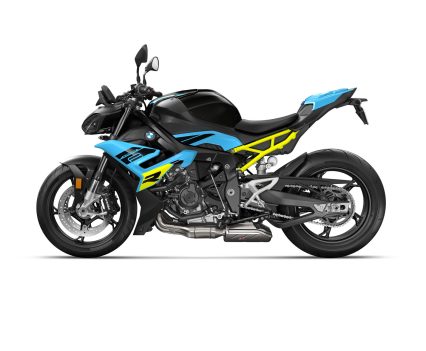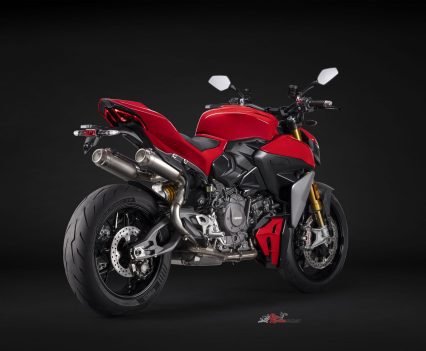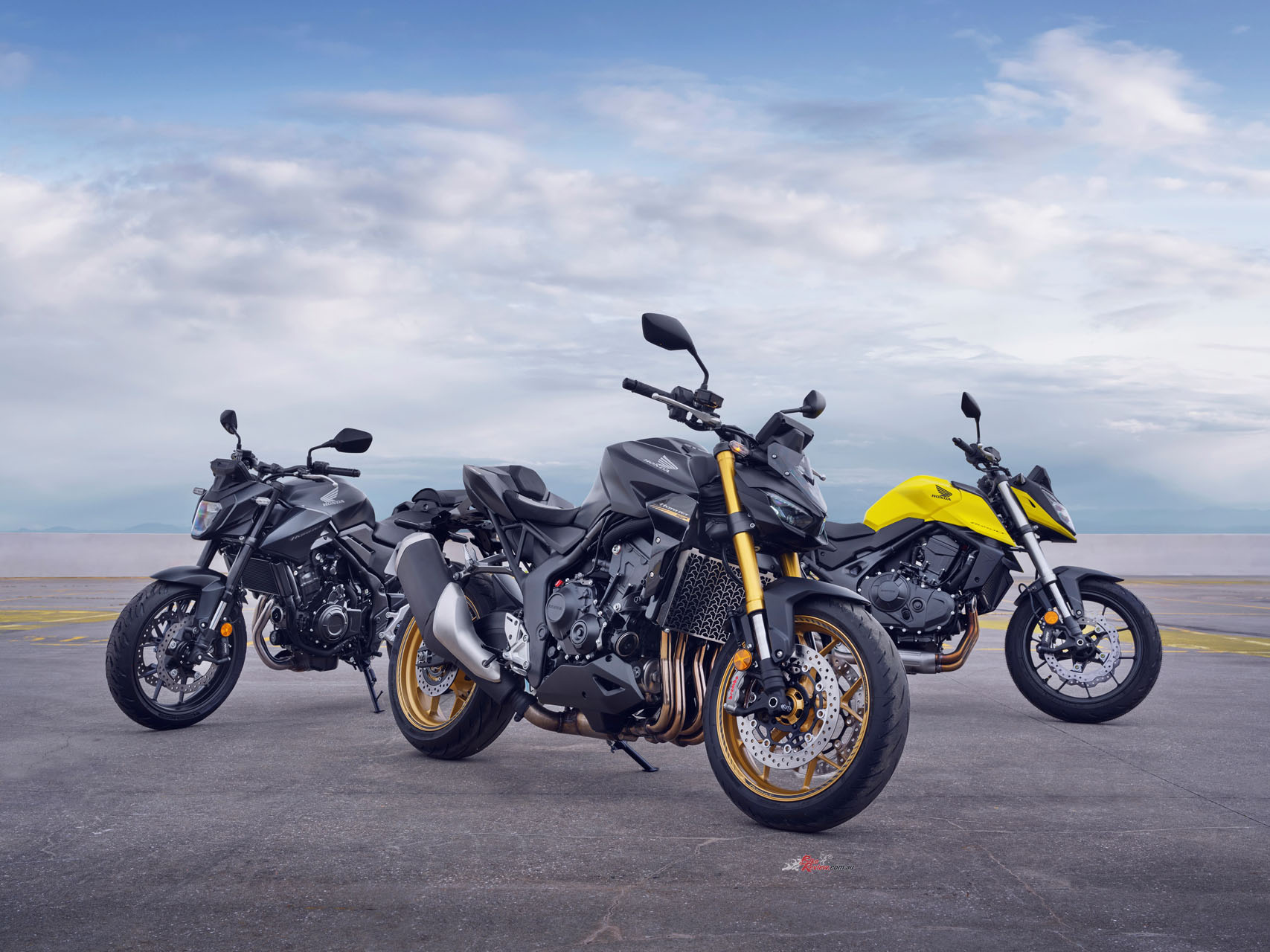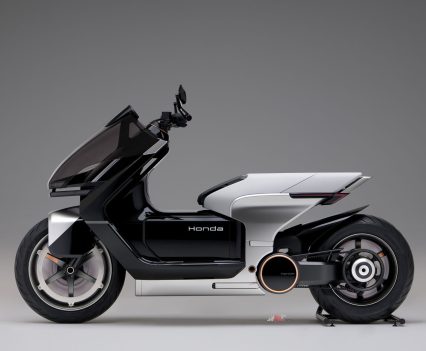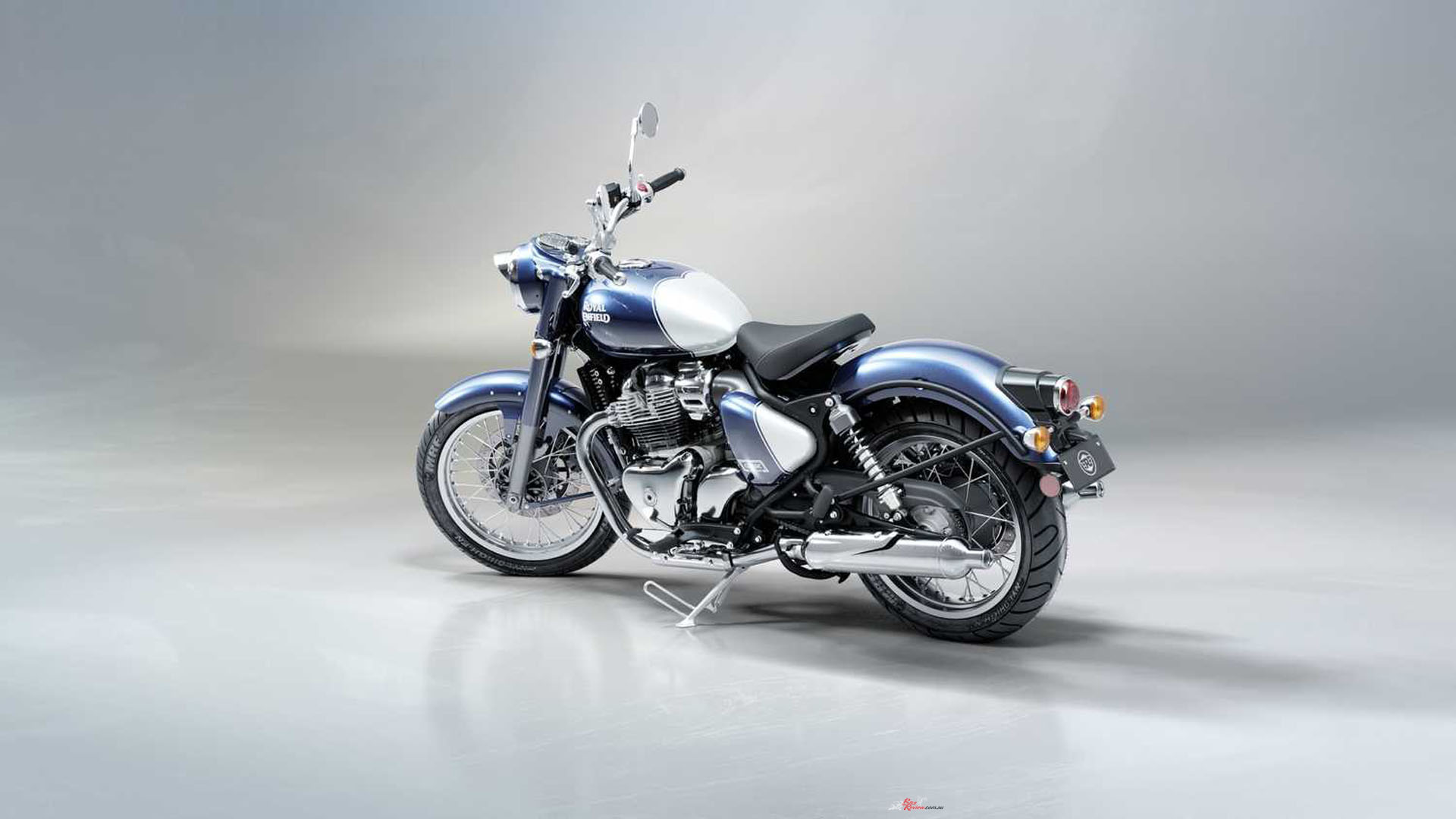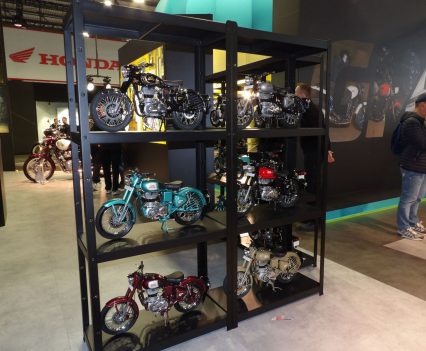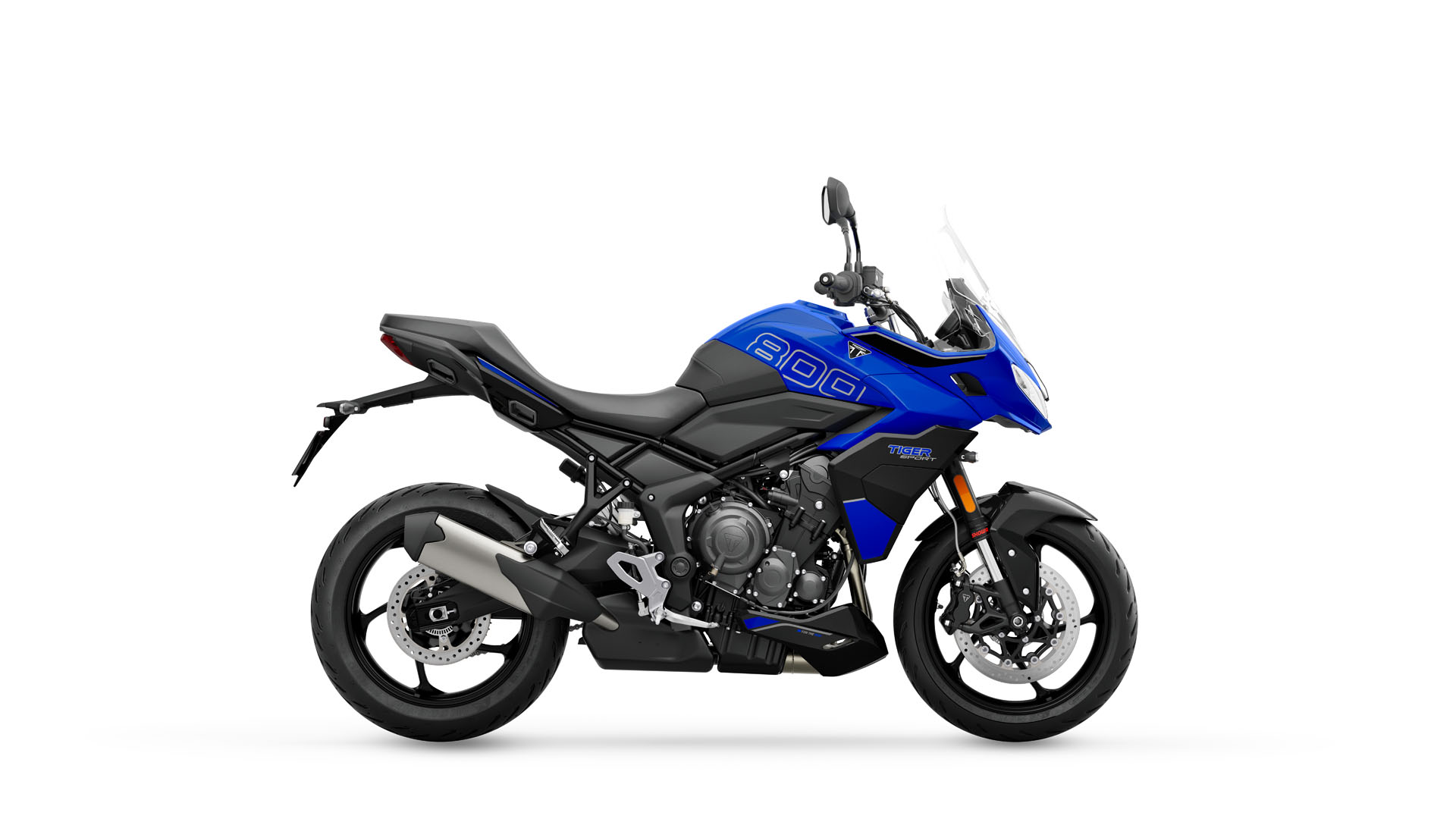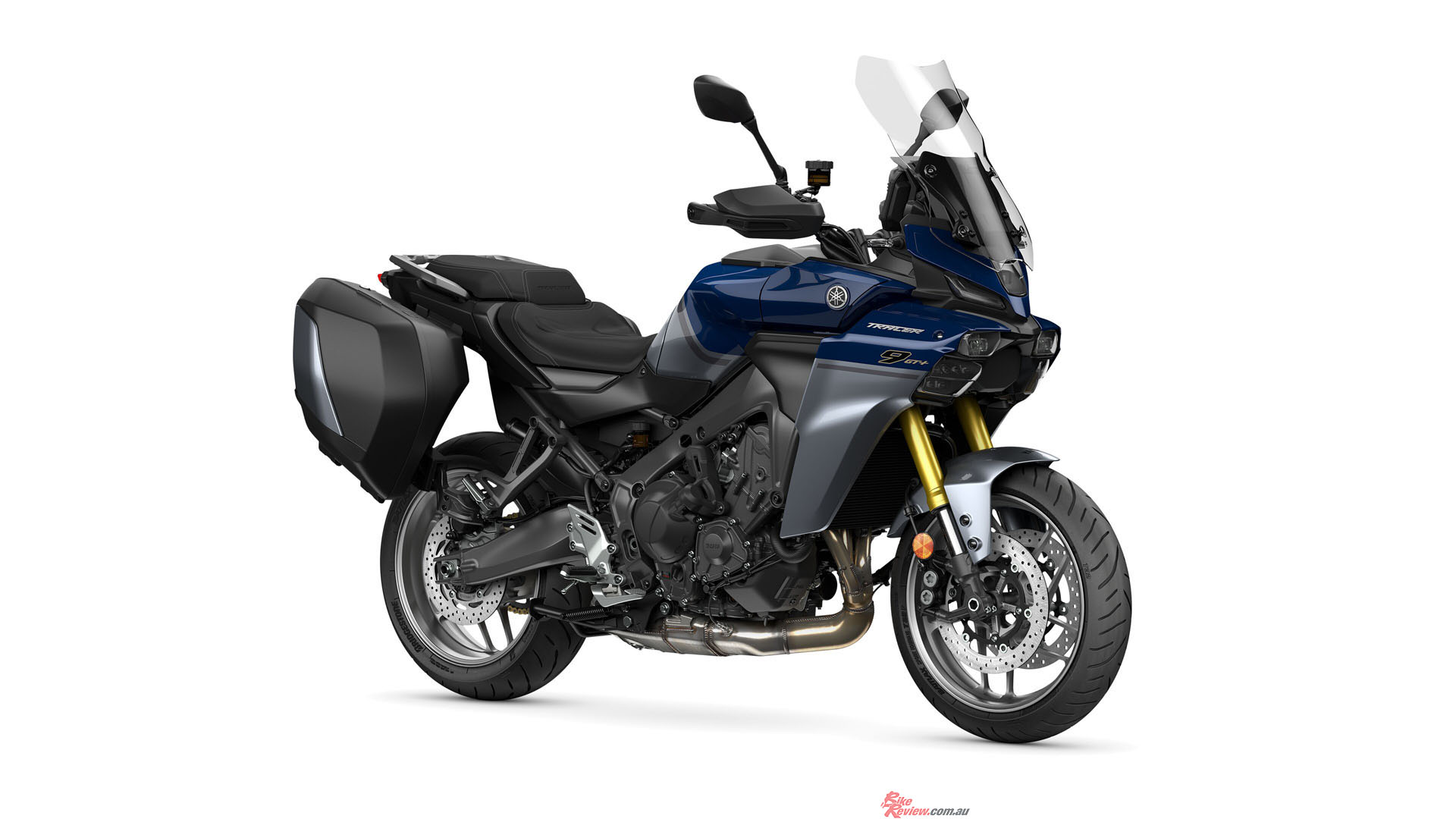Kellie Buckley heads to EICMA 2024 to check out some of the most interesting new and updated models from the major brands that we can expect to land Down Under in Q1 of next year...
Touted as one of the most important events on the motorcycling calendar, the annual EICMA event held in Milan’s Rho Fiera is the stage on which the world’s motorcycle manufacturers choose to unveil new machinery that will be added to the following year’s line-up…
Now in its 110th year, the 2024 iteration of EICMA – or Esposizione Internazionale Ciclo Motociclo e Accessori – comprised of 10 enormous expo halls filled with new two-wheeled offerings. Here are the highlights from Aprilia, BMW, Ducati, Honda, Indian, Moto Guzzi, Royal Enfield, Suzuki, Triumph, Vespa, CFMOTO, Kawasaki and Yamaha…
Check out the 2025 CFMOTO News and New Models from EICMA here…
Check out the 2025 Kawasaki Z900, Ninja 1100SX and SX SE and Versus 1100 models here…
Aprilia
Aprilia had a handful of new models on show at EICMA, headlining with an up-spec Rally version of its 660cc Tuareg adventure offering. Based on the bike built to compete in (and win!) both the Africa Eco Race and the Italian Motorally championship, the 2025 Aprilia Tuareg Rally has a clear off-road focus evidenced by its high front guard, aluminium bash plate, stronger forged-aluminium wire-spoked wheels and sturdier handguards. As well as new off-road focussed mapping, the internals of the KYB fork have been uprated to cope with more gruelling conditions, both the seat and handlebar have been raised to accomodate a rider spending more time standing and, thanks in part to a new titanium muffler, the bike has a claimed wet weight of just 199kg.
The Rally was joined by a stripped-back Tuono version of the RS 457 sportsbike which distinguishes itself from its growing number of 400cc parallel-twin rivals by its aluminium frame. Like its RS sibling, it boasts three switchable riding modes, as well as ABS and traction control.
There were plenty of notable updates to existing model families, with both the 1100cc RSV4 and Factory version benefiting from new aerodynamics, a new TFT dash to access the updated electronics which are now said to have predictive functions. This means the the adaptive intervention is based on conditions and riding style. In Tuono guise, the V4 engine is given 134kW while the RSV4 Superbike gets a 22.3kW boost to 164kW which Aprilia says makes it the most powerful type-approved production superbike on the planet.
Elsewhere, a higher-spec Factory version of the RS660 was unveiled, replete with Öhlins suspension a more powerful 78kW engine.
BMW
A host of small but significant updates have ben applied to BMW’s four-tiered 1000cc range, with the S 1000 R, M 1000 R, S 1000 RR and M 1000 RR all now meeting the Euro 5+ emissions mandate. The new rotation angle on the M bikes’ throttle is said to make for a more responsive yet predictable power delivery, the M winglets are now made of carbon-fibre.
A new steering-angle sensor facilitates a new Slide Control function on the M’s Dynamic Traction Control system. The 2025 S 1000 RR will have the Pro ride modes as standard, while both the M and S version of the nakedbike get the same dual-flow headlight as the RRs.
Ducati
Ducati unveiled its new-for-2025 V2 Panigale and Streetfighter models at EICMA, with both bikes powered by the firm’s new 890cc 90-degree V-twin with variable-valve timing. Said to be the lightest Panigale ever, the 2025 Panigale V2 will be good for 89kW at 10750rpm and 93.3Nm at 8250rpm.
As well as the latest-generation electronics package actuated by a six-axis IMU, there are four switchable riding modes and braking is looked after by Brembo’s M50 calipers. Offered in both base and S-model guides, the single-seat S model gets Öhlins suspension compared to the pillion-ready base model’s SHOWA/Sachs setup and a lightweight lithium battery version on the standard bike, resulting in the S weighing in 4kg lighter than the standard bike’s 179kg kerb weight.
The differences are mimicked in the standard and S-model 2025 Streetfighter V2 models, however the standard bike is just one kilogram heavier than the S-model’s 176kg kerb weight.
Honda
Joining Honda’s CB750 Hornet for 2025 will be the CB1000 Hornet as well as a top-shelf SP version, both of which were unveiled at this year’s EICMA event. Powered by a detuned version of the CBR1000RR engine, it has claimed output figures of 112kW at 11000rpm and 104Nm at 9000rpm, and is mounted within a new twin-spar aluminium frame specifically designed for this application.
Electronic aids are modest, with switchable ride modes which adjusts power, engine braking and Honda’s HSTC traction control system, while the five-inch TFT dash has full connectivity. The base model uses SHOWA suspension, including the big piston SFF-BP fork, while braking is looked after by Nissin. The top-spec SP version gains a performance hike to 115.6kW and 107Nm, and boasts Öhlins suspension as well as Brembo’s Stylema calipers.
As well as a couple of finished-looking electric concepts, Honda used the EICMA event to unveil a new high-efficiency engine its been working on in the form of a 75º V3 fitted with an electrical compressor which has the potential to offer all of the boost of a conventional forced-induction equivalent without any of the lag associated with turbo or superchargers.
Indian
Indian has announced the Scout Sixty Bobber now meets the emission requirements to join the rest of the Scout line-up in international markets such as Australia, where the mid-mount-controls offering will be welcomed by shorter riders. Available in both Standard and Limited trim, the Limited version adds cruise control, traction control, switchable ride modes and a charging port to the otherwise basic base model, which gets mandatory ABS, LED lighting and fuel gauge.
It’s also been announced that both the Indian Roadmaster Elite and the Springfield Special Edition will be reintroduced for 2025 with just 60 and 50 examples respectively being made available across select international markets.
Moto Guzzi
Moto Guzzi used its home show of EICMA to announce some updates to three of its key models. As well as Euro 5+ compliance, the V7 range gains a ride-by-wire throttle which adds selectable riding modes and cruise control to the ABS and traction control capability.
But the big news comes in the form of the V7 Sport being added to the line-up, boasting a level of spec not previously seen on the 853cc range. There’s an adjustable upside-down fork, a twin-disc front braking package and a dedicated Sport ride mode.
The V100 Mandello S also appeared at EICMA, this year debuting the radar-controlled PFF Rider Assistance Solution system which adds forward collision warning, blind spot information and lane-change assist functions.
The other Guzzi news to come out of EICMA is a tribute edition of the Stelvio adventure bike honouring the fact that 2025 will mark 200 years since the iconic road was opened to traffic. Named the Moto Guzzi Stelvio Duecento Tributo, translating to ‘200 Tribute’, there’ll be 2758 units created which reflects the height of the pass in metres.
As well as the special red, white and blue livery, the Duecento Tributo is further distinguished by having heated grips, heated seats, a centrestand, two-way quickshifter, type-pressure monitoring and the PFF system fitted as standard.
Royal Enfield
While Royal Enfield’s intention to join the EV sector in 2026 with the newly announced Flying Flea sub-brand stole most of the Indian brand’s headlines out of EICMA, the firm used its impressively large display to officially show the new-for-2025 Classic 650.
Based on the popular 650cc parallel-twin platform, the Classic 650 draws on all of the firm’s rich heritage to define its traditional styling, including chrome engine cases, wire-spoke wheels and dual-sided exhausts, as well as a single saddle and colour-matched covered fork stanchions.
Royal Enfield also used the event to show several special collaboration custom builds in the form of the Shotgun 650 x ICON Motosport Drop as well as the Guerrilla 450 x El Solitario.
Suzuki
A significantly updated DR-Z400 platform was revealed on the Suzuki stand at EICMA, comprising of a trail bike alongside a new supermotard. Called the DR-Z400S and DR-Z400SM respectively, they’re both powered by the same 398cc single-cylinder power plant that’s now Euro 5+ compliant thanks to some overdue updates, such as a ride-by-wire throttle, a new fuel injection system and a new exhaust with a dual-stage catalytic converter. Other new tech includes selectable ride modes, traction control and switchable ABS.
Both models get a adjustable upside-down KYB fork matched to a fully-adjustable KYB monoshock, the DR-Z400S enduro bike rolls on a 21-inch front tyre matched to an 18-inch rear, while the DR-Z400SM runs more road-orientated 17-inch hoops at both ends.
Triumph
Tech upgrades have been given to both Triumph’s Tiger Sport 660 and Trident 660, with the latter also getting suspension tweaks as well as being joined by the full-powered version which is being made available in Australia for the first time.
Both 660s receive a quickshifter, cruise control as well as cornering ABS and traction control, while the Tiger Sport gains a dedicated sport riding mode. The Trident also gets a fork upgrade to Showa’s big-piston SFF-BF unit while the newly offered unrestricted version available from December this year, ups the power output to 60kW from the 40kW LAMS spec. Torque is also boosted from 59Nm to 63Nm.
Elsewhere in the line-up, the Tiger 850 Sport will be replaced with the new Tiger Sport 800. Powered by a 800cc triple-cylinder engine good for 85kW of power and 83Nm of torque, its upright ergonomics and electronics package place it squarely in the sports-touring segment. As well as ABS and traction control, both of which are lean-angle sensitive, rider aids include cruise control, a two-way quickshifter and three switchable ride modes.
Lastly, a handful of styling, tech and chassis upgrades have been applied to the Speed Twin 900 for 2025. As well as swapping some of its old-school looks for more modern styling, the Speed Twin gets a Marzocchi upside-down front fork while the dual shocks remain at the rear.
Bodywork changes affect the tank, both fenders and the seat, all of which are slimmer than before, while reduced suspension travel, new wheels and larger front discs are aimed at improved handling. In terms of electronics, the ABS and traction control systems are now lean-angle sensitive, and accessed via a new LCD instrument cluster with an integrated TFT display.
Vespa
Vespa used EICMA to whip the covers off what it says is its most powerful scooter in the brand’s history. Powered by a 310cc single-cylinder Euro 5+ compliant engine, the Vespa GTS 310 puts out 18.5kW which is delivered to the road via 12-inch tyres. As well as ABS and traction control, there’s keyless ignition, an LED headlight and a USB charging point underneath the seat.
Yamaha
A heavily updated MT-07, the latest-generation TMAX maxi-scoot, a handful of electronic additions for the Ténéré 700 as well as some notable tweaks to the expanding R-series line-up summed up Yamaha’s announcements at this year’s EICMA.
Ensuring one of the brand’s most popular models stays that way, Yamaha has thrown significant updates at both the LAMS and full-powered versions of its MT-07 twin-cylinder nakedbike. As well as new bodywork resulting in sportier ergonomics, lighter wheels to reduce the unsprung weight and engine acoustic enhancement that’s emitted through openings on the tank cover, an updated chassis spells between a 12 and 13 percent increase in torsional, longitudinal and lateral rigidity.
A new 41mm upside-down fork and new four-piston calipers headline the component upgrades, while a new digital throttle will facilitate adjustable power, as well as traction control and switchable ride modes. It was also announced that the full-power version will also be offered with the firm’s semi-automatic transmission.
Speaking of Y-AMT, or Yamaha’s Automated Manual Transmission, the Tracer 9 GT+ will gain the system for 2025, as well as smattering of other upgrades. There’s new bodywork which grants more space for the rider and pillion, a larger adjustable windscreen, a new adaptive LED headlight and a seven-inch TFT dash to control its sophisticated suite of radar-controlled rider aids. The panniers are now centrally lockable and there’s a new powered storage compartment for devices.
Twenty-six years after it made its debut, the 2025 TMAX scooter will be the cleanest and most advanced yet. The 560cc twin-cylinder engine now meets Euro 5+ compliance, it’s wrapped in new bodywork that gives the original maxi scooter a new face, while brake control joins the list of rider aids. Called the TMAX Tech MAX, its seven-inch TFT dash gets enhanced connectivity, the screen is electrically adjustable, there’s heated grips, seats, tyre pressure monitoring and new backlit switches.
Yamaha also used EICMA to announce some updates to its Ténéré 700 adventure offering, with a new fully-adjustable 43mm front fork with a preload adjuster now accessible on the top of each fork leg, matched to a revised shock with a remote adjuster and a new linkage at the rear. There’s new bodywork, a 6.3-inch vertical TFT dash for the first time and new switchblocks, while the two-piece seat of previous years has been replaced with a one-piece rally-style unit. Other comfort improvements come in the form of larger footpegs and a revised clutch cover to reduce leg interference.
Lastly, the Iwata factory used the stage to display its long-awaited YZF-R9 triple-cylinder sportsbike alongside its two updated YZF-R1 and YZF-R3 siblings. Despite no longer meeting the emission requirements to be sold as a roadbike, Yamaha has announced some updates for its YZF-R1 superbike as it looks to remain competitive on the racetracks. The base model gains the most amount of improvements with a new fully-adjustable KYB fork, higher-spec Stylema calipers from Brembo matched to a new master cylinder, while both the YZF-R1 ad the YZF-R1M have been endowed with large carbon-fibre winglets and a new seat cover.


























